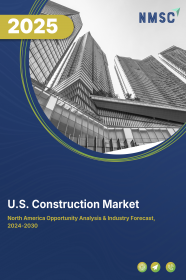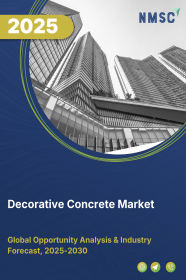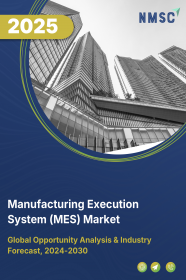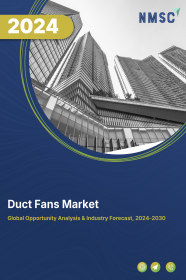
U.S. Construction Market by Type (Renovation, and New Construction), by Sector (Real Estate, Infrastructure, and Industrial), by Construction Method (Traditional Construction, Prefabricated/Modular Construction, 3D Printed Construction, and Green/Sustainable Construction), and by Type of Contractor (Large Contractor, Medium Contractor, and Small Contractor) – Industry Trends and Forecast, 2025–2030
Industry: Construction & Manufacturing | Publish Date: 08-Aug-2025 | No of Pages: 85 | No. of Tables: 117 | No. of Figures: 62 | Format: PDF | Report Code : CM2194
U.S. Construction Industry Overview
The U.S. Construction Market size was valued at USD 1.77 trillion in 2024, and is projected to grow to USD 2.12 trillion by 2025. Additionally, the industry is expected to continue its growth trajectory, reaching USD 2.52 trillion by 2030, with a CAGR of 2.6% from 2025 to 2030.
The U.S. construction market is experiencing significant growth, driven by large-scale investments in infrastructure projects like the Hudson Tunnel Project, Brightline West High-Speed Rail, and the Gordie Howe International Bridge, which are enhancing transportation and connectivity.
Government-led initiatives, including funding from the Bipartisan Infrastructure Law, are also fueling this expansion, with numerous projects aimed at modernizing roads, bridges, airports, and energy infrastructure.
However, the market faces challenges due to complex regulatory processes and permitting requirements, which can delay projects and increase costs. At the same time, the integration of digital technologies like Building Information Modeling (BIM), AI, and IoT is creating new opportunities for enhanced project efficiency and collaboration, further supporting market growth.
Economic Resilience and Rising Investment Confidence Fuel Construction Growth
The U.S. construction market is gaining solid traction as economic stability strengthens and investor sentiment improves. A supportive financial landscape—characterized by low-interest rates, targeted fiscal measures, and increased private capital inflow—is stimulating activity across key construction segments. Recovery momentum is especially evident in residential, commercial, and industrial builds, where both new starts and revived projects are on the rise. Infrastructure initiatives, bolstered by federal and state-level programs, are also accelerating, with a growing focus on modernizing transportation, utilities, and logistics networks. This renewed investment climate is reinforcing confidence among developers, contractors, and institutional investors.
Urbanization and City Modernization Drive Infrastructure Demand
The rapid growth of urban centers across the U.S. is transforming city landscapes and reshaping construction priorities. With a significant portion of the population now concentrated in metropolitan areas, the demand for housing, efficient mobility systems, and smart public infrastructure is escalating. Cities are embracing forward-looking development frameworks—emphasizing high-density housing, mixed-use neighborhoods, and climate-resilient infrastructure. Regional planning authorities are actively rolling out urban regeneration programs that promote sustainable land use, energy-efficient buildings, and inclusive community spaces. This wave of city modernization is creating a sustained pipeline of construction projects aimed at future-ready urban ecosystems.
Complex Regulatory Landscape Slows Project Delivery
The U.S. construction industry faces persistent challenges stemming from regulatory and administrative complexities, even in the context of favorable market dynamics. Permitting processes remain fragmented and time-consuming, as different states and municipalities follow varied standards and approval protocols. Navigating these decentralized systems often leads to extended project timelines, increased compliance costs, and reduced predictability for developers. Additional delays stem from evolving environmental regulations, zoning restrictions, and legal reviews—particularly for large-scale or environmentally sensitive projects. These procedural inefficiencies, coupled with workforce shortages and supply chain pressures, continue to hinder timely and cost-effective construction delivery.
Tech-Driven Innovation Paves the Way for Smart, Efficient Construction
Digital transformation is reshaping the U.S. construction landscape, unlocking new opportunities for innovation and operational efficiency. The widespread adoption of Building Information Modeling (BIM), digital twin technology, and connected site solutions is driving a shift toward smarter, more integrated construction practices. Prefabrication and modular construction techniques are also gaining traction, offering faster delivery timelines and reduced environmental impact. Government mandates and industry demand for tech-enabled transparency, sustainability, and cost control are accelerating this trend. As construction firms embrace digital workflows and automation, the sector is poised to benefit from enhanced productivity, better resource management, and a competitive edge in high-performance building solutions.
Competitive Landscape
The key players operating in the U.S. construction industry include Turner Construction Company, Bechtel Corporation, Kiewit Corporation, MasTec Inc., HITT Contracting Inc., Fluor Corporation, McDermott International, PCL Construction Enterprises Inc., Skanska USA, Gilbane Building Company, CLARK GROUP, Mortenson, DPR Construction, Hensel Phelps, Holder Construction, and others.
U.S. Construction Market Key Segments
By Type
-
Renovation
-
New Construction
By Sector
-
Real Estate
-
Residential
-
Affordable
-
Luxury
-
-
Commercial
-
Retail Buildings
-
Office Buildings
-
Hospitality
-
Healthcare Facilities
-
Educational Institutes
-
Entertainment Ventures
-
-
-
Infrastructure
-
Transportation
-
Airport
-
Port
-
Rail
-
Road
-
-
Water and Wastewater
-
Energy
-
Telecommunication
-
-
Industrial
-
Manufacturing Plant
-
Warehouses
-
Power Plants
-
Oil Refineries
-
Chemical Plants
-
By Construction Method
-
Traditional Construction
-
Prefabricated/Modular Construction
-
3D Printed Construction
-
Green/Sustainable Construction
By Type of Contractor
-
Large Contractor
-
Medium Contractor
-
Small Contractor
Key Players
-
Turner Construction Company
-
Bechtel Corporation
-
Kiewit Corporation
-
MasTec Inc.
-
HITT Contracting Inc.
-
Fluor Corporation
-
McDermott International
-
PCL Construction Enterprises Inc.
-
Skanska USA
-
Gilbane Building Company
-
CLARK GROUP
-
Mortenson
-
DPR Construction
-
Hensel Phelps
-
Holder Construction
REPORT SCOPE AND SEGMENTATION:
|
Parameters |
Details |
|
Market Size in 2024 |
USD 1.77 Trillion |
|
Revenue Forecast in 2030 |
USD 2.52 Trillion |
|
Growth Rate |
CAGR of 3.6% from 2025 to 2030 |
|
Analysis Period |
2024–2030 |
|
Base Year Considered |
2024 |
|
Forecast Period |
2025–2030 |
|
Market Size Estimation |
Trillion (USD) |
|
Growth Factors |
|
|
Companies Profiled |
15 |
|
Market Share |
Available for 10 companies |
|
Customization Scope |
Free customization (equivalent up to 80 working hours of analysts) after purchase. Addition or alteration to country, regional, and segment scope. |
|
Pricing and Purchase Options |
Avail customized purchase options to meet your exact research needs. |

















 Speak to Our Analyst
Speak to Our Analyst





















